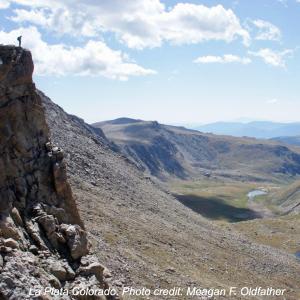North Central Mountain Climate Adaptation
Date
The alpine ecosystem, and mountain ecosystems in general, contain unique and climate sensitive biodiversity, as well as provide recreation and water resources for many people. These ecosystems may play an outsized landscape-level role in shielding species from climate change by acting as refugia, or, “safe havens”, according to Dr. Meagan Oldfather, USGS biologist and project advisor for “Climate Adaptation in the North Central Mountains: Alpine Tundra and Treeline”. This 2023 Rapid Climate Assessment Program project brought together experts from the US Geological Survey (USGS), the North Central Climate Adaptation Science Center (NC CASC), and Conservation Science Partners (CSP) to summarize climate dynamics and climate responses of North Central mountain flora and fauna.
The warmer spring and summer temperatures resulting from climate changes cause more glacial, snow and permafrost melt in the upper alpine of the North Central mountains. As climate changes progress, this ecosystem is not only going to experience more warming in the future, but likely also overall drier conditions. Alpine species that have adapted to the coldest parts of the landscape may experience a “mountaintop squeeze”, in which they have limited opportunities to move uphill to more suitable environments. However, the topographic ruggedness and high variability of seasonal and year-to-year climate in the alpine may dampen the speed at which populations, communities, and the overall ecosystem responds to climate change, providing an opportunity to conserve and protect these systems.
Dr. Imtiaz Rangwala, a NC CASC research scientist involved with the study, believes that we need to better anticipate how transformations in these alpine ecosystems may play out in the coming decades, including “what role would extreme climate events and associated disturbances play in affecting the rate and trajectory of ecosystem and biodiversity transformations under a changing climate?” Dr. Oldfather adds that understanding how the dynamics of extinction debt (defined as future extinction of species due to current changes in climate) will play out in these ‘slow’ systems is important, as is learning how we can help “reduce biodiversity loss when the debt comes due.”
Read more about the team’s findings here.


